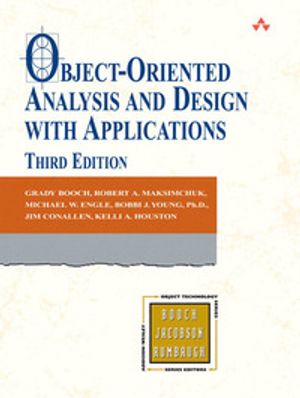Vi har bytt namn till Adlibris Campus! Campusbokhandeln ❤️ Adlibris - Läs mer här

Object-Oriented Analysis and Design with Applications | 3:e upplagan
- Inbunden, Engelska, 2007
- Författare: Grady Booch, Robert Maksimchuk, Michael Engle, Bobbi Young, Jim Conallen, Kelli Houston
- Betyg:
Finns i lager i .
Beskrivning
Preface xiii
Acknowledgments xix
About the Authors xxiSection I: Concepts 1Chapter 1: Complexity 3
1.1 The Structure of Complex Systems 4
1.2 The Inherent Complexity of Software 7
1.3 The Five Attributes of a Complex System 12
1.4 Organized and Disorganized Complexity 14
1.5 Bringing Order to Chaos 18
1.6 On Designing Complex Systems 24
2.1 The Evolution of the Object Model 29
2.2 Foundations of the Object Model 37
2.3 Elements of the Object Model 43
2.4 Applying the Object Model 71
3.1 The Nature of an Object 75
3.2 Relationships among Objects 88
3.3 The Nature of a Class 92
3.4 Relationships among Classes 96
3.5 The Interplay of Classes and Objects 111
3.6 On Building Quality Classes and Objects 112
4.1 The Importance of Proper Classification 121
4.2 Identifying Classes and Objects 126
4.3 Key Abstractions and Mechanisms 138
5.1 The Unified Modeling Language 147
5.2 Package Diagrams 155
5.3 Component Diagrams 163
5.4 Deployment Diagrams 171
5.5 Use Case Diagrams 175
5.6 Activity Diagrams 185
5.7 Class Diagrams 192
5.8 Sequence Diagrams 206
5.9 Interaction Overview Diagrams 213
5.10 Composite Structure Diagrams 215
5.11 State Machine Diagrams 218
5.12 Timing Diagrams 231
5.13 Object Diagrams 235
5.14 Communication Diagrams 238
6.1 First Principles 248
6.2 The Macro Process: The Software Development Lifecycle 256
6.3 The Micro Process: The Analysis and Design Process 272
7.1 Management and Planning 304
7.2 Staffing 308
7.3 Release Management 312
7.4 Reuse 314
7.5 Quality Assurance and Metrics 316
7.6 Documentation 320
7.7 Tools 322
7.8 Special Topics 324
7.9 The Benefits and Risks of Object-Oriented Development 326
8.1 Inception 334
8.2 Elaboration 347
8.3 Construction 370
8.4 Post-Transition 371
9.1 Inception 376
9.2 Elaboration 385
9.3 Construction 396
9.4 Post-Transition 411
10.1 Inception 414
10.2 Elaboration 421
10.3 Construction 427
10.4 Post-Transition 446
11.1 Inception 450
11.2 Elaboration 463
11.3 Construction 474
11.4 Post-Transition 487
12.1 Inception 490
12.2 Elaboration 494
12.3 Construction 506
12.4 Transition and Post-Transition 534
A.1 Language Evolution 537
A.2 Smalltalk 541
A.3 C++ 546
A.4 Java 551
Glossary 591
Classified Bibliography 603
Index 677